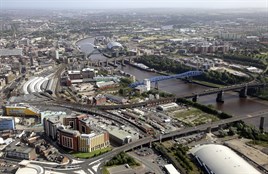 Download the graphs for this feature.
Download the graphs for this feature.
Jobs, housing and economic growth are a priority across the UK. To achieve this, cities - and their transport infrastructure - matter. Cities are the drivers of innovation and of economic growth and performance - not only today, but also increasingly as our need to compete in the world economy intensifies.
We delude ourselves if we believe that we can opt out of such competition. Our current standard of living is not a birthright. If real wages are to start growing again and if our children are to be better off than we are, we will need to invest to keep up at the top of the value chain and to continue creating the new opportunities that made this relatively small country among the richest in the world.
This means that we must invest in our cities. Not only because 60% of jobs are in cities (which cover less than 10% of our land mass), but also because cities are where innovation and new ideas come to fruition.
Over recent decades, a modern knowledge economy has flourished in our cities, at the heart of dynamic city regions. They have shown how larger centres can generate greater density and higher wages, if supported by good transport systems both for the labour market and for business-to-business access.
For cities, jobs and productivity are related to density (see diagram, page 22). The diagram compares wage levels and density across the largest local authority districts, and illustrates this curve. The densest and most highly paid districts are all in London, where there is also a high concentration of private sector knowledge-intensive jobs (51% in 2011). The other major cities are all in a middle range of densities, and have not all yet achieved relative wages significantly above the average.
Crucial to the role of a city is the existence of its city centre. This is where the intensity of communication takes place that can generate a successful location. Increasing the scale of such centres enables individual and business specialisation that in turn generates diversity in a city’s offering.
Diversity is related to a city’s ability to attract sufficient density of knowledge-intensive jobs. Work carried out by the Centre for Cities has established this. The cities with higher proportions of knowledge-intensive business services-based jobs (KIBS) also have higher relative earnings for a given density - Newcastle and Nottingham do less well than Birmingham or Manchester, for example. Achieving greater densities needs to go alongside achieving the range of knowledge-intensive roles that are apparent across London, where both wages and densities are highest alongside high proportions of knowledge-intensive roles.
The city advantage rests fundamentally on communications. Cities allow people to get together, exchange ideas, use resources more effectively and be creative. Transport systems make it possible to achieve this, as well as making the wider connections to other experts, to markets, and to wider ideas. Even digital economies
still need physical connections, as Silicon Valley shows.
So the question on which we must focus is how best to enable the range of communications needs that cities require in order to thrive and what the right mix of investments is - particularly in physical transport. A process known as agglomeration drives success in cities. It was first observed in Manchester. As the scale of the labour market increased, so too could its efficiency, with better matching between jobs and people as well as more choice for both employees and employers.
The importance of this has risen in recent decades, with the proportion of two-earner households and the flexibility that this requires. Marketing new ideas between businesses is easier in a larger market, as is generating them in the first place. Facilitating the emergence of new specialisations adds to the diversity and attractiveness of the business centre, and creates positive feedback.
A recent example might be the emergence of King’s Cross as a new business area. Reinvestment in the area’s railway stations, coupled with the high-speed line to the Channel Tunnel, encouraged additional public and private investors - from new offices to St Martin’s School of Art, Kings Place concert hall, the British Library and the Francis Crick research institute. A down-at-heel area once known chiefly for drug addiction and prostitution has been completely transformed.
Creating emerging centres is not a centrally driven process, it relies on integration between development, policy, transport and market forces. We know from cities around the world that devolution and more integrated approaches to investment will secure better infrastructure, unlock growth and create new, locally-determined funding opportunities. Centralised decision-making, on the other hand, means that transport decisions are evaluated independently of their impact on the economy or interaction with other policies, something that astonishes non-economists and even some politicians.
And Britain’s cities are among the least devolved in the world, with very little control over services, funding or borrowing. This constrains their ability to give a clear focus across policies at the local level, to promote sources of competitive advantage in the interests of local and national productivity.











